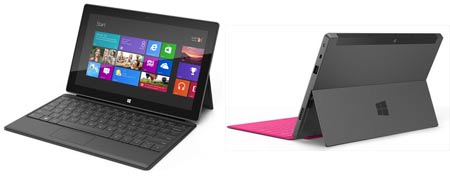My quick hands-on with the new 10.6-in. Surface tablets at Microsoft’s launch on Monday gave me a little surprise: The edges on all four sides are sharp.
I was expecting something a little smoother or rounder, for whatever reason. The black magnesium back cover and the black bezel on the front around the screen make the Surface tablet seem more in the Android camp than iPad’s.
But the weight, at less than 2 pounds, felt great. Engineers showed off the materials in the tablets and emphasized durability of the case, along with the Corning’s Gorilla Glass screen. I guess here’s the direction Microsoft wanted to take with Surface tablets: durable, with an emphasis on seriousness.

Microsoft has designed its own tablet to compete with the iPad.
The Microsoft Surface tablet, unveiled late on Monday, comes with a built-in “kickstand.”
The keyboards embedded in the two covers are, to me, the secret sauce with the new Surface tablets. One is a Touch Cover, with no mechanical keys, while the other is a Type Cover, with keys that are mechanical and provide resistence for touch typing. Both are the same size.
Both covers work on both machines, the Windows RT and the Windows 8 Pro. The Type Cover has more information n the top row of keys, something that shows they can be used as shortcuts to various apps that might run already in Windows.
I fiddled with the resistive keys and felt they were of the right size, spacing and resistance, but my time was short for a full eval of typing fast as I do on a laptop.
Microsoft is hyping the new tablet with a promotional video.
There is an onscreen keyboard, buy Microsoft didn’t even demo it at the event.
I’m a little worried about the sharp edges, but Windows 8 and touchscreen functionality is encouraging.
Oh, there’s a kickstand on the back of each tablet, so that you can prop it up without the cover. I’ve learned by craning my neck over my iPad while using the onscreen keyboard that my neck can get tired quickly. So bravo to Microsoft engineers on behalf of my neck.
Geek note: Inside each cover is an actual accelerometer that can tell the cover’s orientation compared with the tablet, so that it knows whether it is being used folded over the screen or the back or is being used as keyboard. The advantage is not having to remove the cover for various purposes, which could be a good thing. I’ve fiddled with the iPad’s cover a lot.
One minor thing I learned, though, is that if you open the kickstand, you have to have the cover attached at the end of the Surface near the kickstand in order for it to open as a keyboard. Not an inconvenience, really, but of interest.
I think much of the success of these tablets will come down to price and how much Windows 8 appeals, either as a Pro edition or Windows RT. Nothing in the design is a fatal flaw. But unfortunately, I can’t say they are dream machines, either.
Matt Hamblen covers mobile and wireless, smartphones and other handhelds, and wireless networking for Computerworld.




